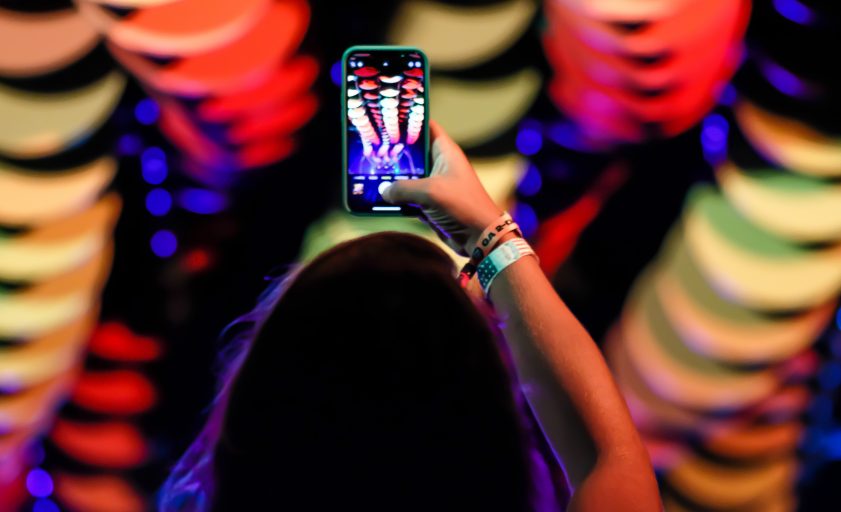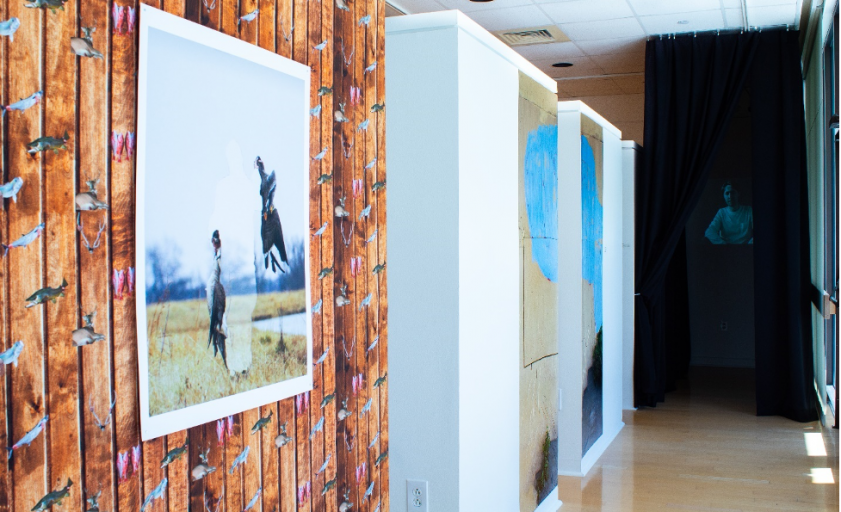Immersing Tampa Bay
By Jessica Todd
Over the past decade, immersive art has grown from a niche market to mainstream popularity, much to the delight or disgust of many in the art world. From rotating projections of Starry Night to Meow Wolf’s growing repertoire, an increasing number of mainstream audiences are engaging with this medium. As it grows, we are challenged to define it, evaluate it, and integrate it into our own arts communities. Tampa Bay is eager to join the conversation—and has a lot to offer to it—with an array of examples from our own past, present, and future.
Immersive Art and its Origins
To discuss immersive art, we first need a definition: Generally, immersive art is an embodied, 360-degree experience where the boundary between “viewer” and “art” is dissolved through active participation and multi-sensory engagement. Primarily rooted in the visual arts, other disciplines including theatre, music, story-telling, film/video, dance, fashion, and culinary arts may play a role. Many definitions out there cite virtual reality, video projection, and laser light shows, but that only represents one approach; immersive art may also be created from more tactile, traditional processes.
“Immersive art…has a simple definition—it’s the creation of a world around the person in a way that makes them feel part of and inside of it. In practice, the label of immersive art touches on everything from illusory world-building to simply including a piece of interactivity within a larger, traditional art show. The true meaning of immersive art is somewhere between those two things…[it] must create something that moves beyond the fourth wall…bringing viewers into the art and augmenting their reality.”1
Immersive art seeks to demolish the division between capital-A “Art” and life, and between art object and viewer, but the concept behind this 21st-century trend is nothing new. Throughout history and around the globe, more often than not, art and life have been deeply integrated. For example, among the thousands of cultural groups across the vast continent of Africa—such as the Yoruba, Igbo, and Dogon people—visual, performance, and literary arts are inseparable from each other and from the participatory ceremonies they accompany. (For this reason, it is absurd to display them as stand-alone “art” objects in Western museums.)
Such ceremonial markers of holidays and life’s milestones are—in Western terms—interdisciplinary, embodied art experiences. These events incorporate community members to such a degree that there is no distinguishing lexicon for “art” as a stand-alone concept in many global languages. Hand-crafted objects, costuming, music, food and drink, spoken word, dance, and theater are combined together and imbued with symbolism to create authentic, transformative experiences for participants. There is no line between “art” and “audience” because the participation of all parties is a fundamental element.2 We must acknowledge the deep history and global presence of this approach to the “arts,” lest we support the false narrative that it is a contemporary, Western invention.
Art, That’s Immersive
The canon of Eurocentric Art History includes early examples of immersive or experiential art occurring in more traditional museum and gallery settings:
- Andy Warhol’s Silver Clouds, first exhibited at Leo Castelli Gallery in New York City in 1966, lives on in contemporary iterations. The gallery is filled with rectangular metallic silver balloons that reflect the environment around them and belie their hefty appearance to float whimsically from floor to ceiling. Viewers are invited to walk amongst them and touch them, their movements becoming an integral element of the artwork.3
- In 1971, Robert Morris filled the Tate Gallery (now Tate Britain) sculpture hall with “interactive sculptures that would experiment with conceptions about sculptural space and human physicality by having museum-goers put their own bodies to the test.” Minimalist sculptural objects such as ramps, cylinders, and beams were transformed into useful objects, emphasizing the viewers’ interactions with them as the “art,” and the sculptures as a tool to achieve an embodied aesthetic experience.4
- The Rothko Chapel in Houston, Texas, first completed in 1971, is an octagonal brick building with a skylight, containing 14 murals by Mark Rothko in varying shades of black. It is “a spiritual space, a forum for world leaders, a place for solitude and gathering. It’s an epicenter for civil rights activists, a quiet disruption, a stillness that moves.”5 Its somber interior is designed to engulf the viewer and foster deeper contemplation. In the words of Tampa-based artist and educator Noelle Mason, Rothko Chapel is “immersive but not entertaining.”6
- Yayoi Kusama has become a global sensation for her polka-dotted infinity rooms, including the 2018 exhibition Love is Calling at the Tampa Museum of Art (heralded by Tampa Bay Times as “incredibly Instagram-able.”7) But the 93-year-old artist has been making viewer-interactive artwork since 1966, when she was banned from performing with her controversial work Narcissus Garden at the Venice Biennale: Kusama, dressed in a kimono, sold the mirrored vinyl balls that comprised the installation to passersby for 2 dollars each, a critique of the commercialization of art.8
- James Turrell’s “skyspaces,” a series initiated in 1973, feature an “aperture cut into the roof of a building that causes the visible plane of the sky to appear flat at the level of the opening.” They encourage experiential interaction by the viewer and a suspension of time and space.9 One of these—Joseph’s Coat—is installed at the Ringling Museum in Sarasota.
- Ai Weiwei’s Sunflower Seeds (2010) consists of a pile of millions of unique handcrafted porcelain sunflower seed replicas on which the public is encouraged to walk. This interaction symbolizes the “complex exchanges between the one and the many.”10
- A recent example is Ernesto Neto’s SunForceOceanLife (2021), a “hand-crocheted, walkable maze of yellow, orange, and green threads that stretch 79 feet across the gallery and spiral 12 feet in the air.”11 This joyful piece turns museum-goers from passive observers into active playmates, all inside of the austere white box of the gallery.
Self-Identified “Immersive Art Experiences”
The name most likely to draw recognition of the immersive-art-experience world is Meow Wolf. The group started as a grassroots team of outcasts from the Santa Fe, NM arts scene who turned a rented warehouse into a punk art space in 2008. They opened their first permanent immersive art installation, House of Eternal Return, in 2016, drawing 400,000 visitors—almost six times the population of Santa Fe—that year alone.12 Their rapid success drew the attention of investors and they’ve been growing since, with installations Omega Mart (Las Vegas, NV) and Convergence Station (Denver, CO) opening in 2021, and plans to expand to Grapevine, TX in 2023 and Houston, TX in 2024.13
Meow Wolf pioneered a new kind of attraction somewhere in the gray area between art and entertainment. Visitors create their own non-linear journey through a space where everything can be touched and the narrative is unclear. I have yet to visit any of Meow Wolf’s installations myself, so I can’t speak directly to them, but what seems to set them apart from a mainstream attraction like Disney World is their subversive edge, layered conceptual foundation, and eccentric aesthetic. Some in the art world have rejected their work as art, but cofounder Sean Di Ianni says, “We consider what we do to be art—very much. But if the art world doesn’t like that, that’s fine.”14
Since Meow Wolf’s meteoric rise, a number of permanent immersive arts attractions have cropped up around the country and globally, including AREA15 in Las Vegas, NV (which houses Meow Wolf’s Omega Mart, and will open another location in Orlando, FL in 2024); Superblue and Artechouse in Miami, FL; Seismique in Houston, TX; Otherworld in Colombus, OH; Wisdome LA in Los Angeles, CA; teamLab experiences in Shanghai, Tokyo, and Macau, Japan; and Atelier des Lumières in Paris, France.15 It’s fair to say we are well past “trend” territory and well into an art/entertainment hybrid discipline to be reckoned with. Tampa Bay is in on it, too, with Fairgrounds St. Pete opening in December 2021, and Crab Devil’s The Peninsularium slated for 2022. (More on them, soon.)
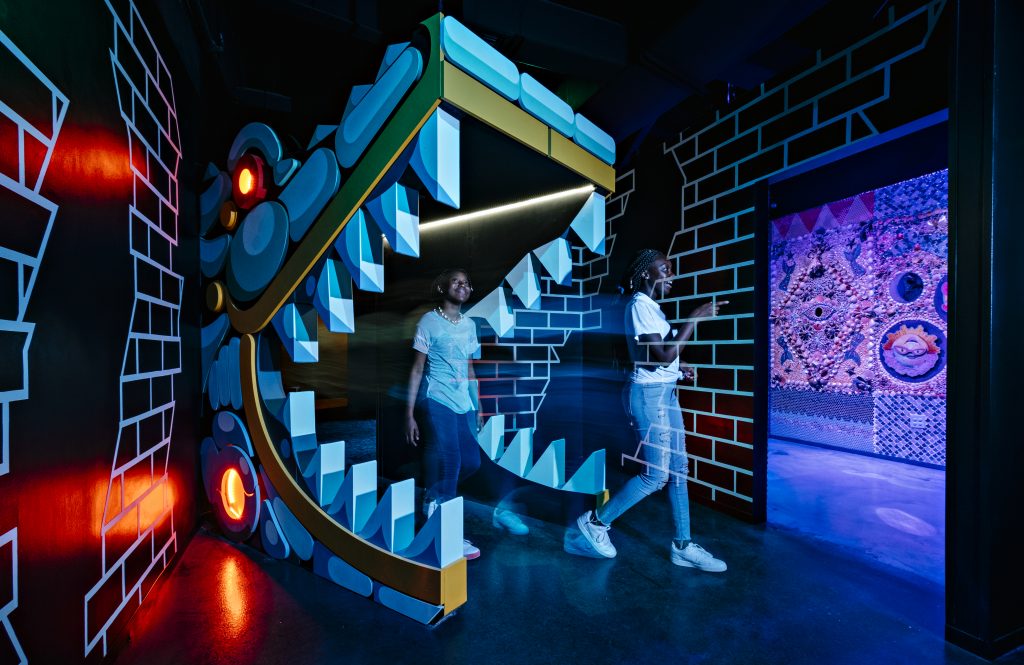
Recent History of Immersive Art in Tampa Bay
I reached out to leaders in Tampa Bay’s art community to hear their thoughts on immersive art in general and the medium’s history and presence in the region. Though the first “true” permanent immersive art attraction opened in 2021 (Fairgrounds St. Pete), there is a long precedent of immersive, interactive, and experiential art in Tampa Bay worth noting.
One of the first names that came to mind for many was the Vinik Family Foundation, which brought the above-mentioned Yayoi Kusama installation to the Tampa Museum of Art in 2018. They also presented the popular installation The Beach Tampa by Snarkitecture at Amelie Arena in 2016. The massive venue featured a “15,000-square-foot immersive environment featuring an “ocean” of 1.2 million recyclable and antimicrobial white balls” and was open to the public free of cost. This whimsical installation inspired joy for visitors of all ages and backgrounds.16
Earlier this year, the Vinik Family Foundation brought Lucy Sparrow’s Tampa Fresh Foods to Water Street. Sparrow’s “grocery store” was filled with over 50,000 handmade felt replicas of common consumable products. Gallery attendants became supermarket associates and Sparrow herself manned the register. Outfitted with shopping baskets, visitors could buy reasonably priced artwork/products, the proceeds of which benefitted the local nonprofits Feeding Tampa Bay and Tampa Arts Alliance.17
Walking into Tampa Fresh Foods, I instantly had a smile on my face—it was pure delight. Coke, ketchup, tampons, and shrimp smiled back at you from the shelves. I must have walked down each aisle ten times, each time seeing something new and remarking to a stranger, “Did you see the green onions?!” For me, the installation was successful beyond pure entertainment because, on closer inspection, it subversively critiqued advertising, excess, over-consumption, waste, and the paradox of choice. Even if you didn’t read into it on that level, it brought a bunch of strangers into a space to smile and laugh together, and that’s something.
One of my favorite examples of Tampa’s immersive-art past is The Music Box: Tampa Bay, created in 2016 in Mann-Wagnon Park in Sulphur Springs along the Hillsborough River. Commissioned by the University of South Florida’s Contemporary Art Museum (USFCAM) in partnership with Community Stepping Stones and curated by Sarah Howard (Curator of Public Art and Social Practice, USF), The Music Box: Tampa Bay followed in the footsteps of the first installation of The Music Box in New Orleans in 2011, a concept for musical architecture developed by New Orleans Airlift (NOA) and artist Swoon. National and local artists and students used reclaimed materials from the site to build sound-producing structures that grew into a musical village. For a month in 2016, the site was programmed with free cultural events, including musical performances, artist talks, historical talks about the history of Sulphur Springs, jam sessions, open mic nights, and yoga. Visitors were invited to open play days where they could make their own sounds and interact with the site.18
When I spoke with Sarah Howard about immersive art and what makes a work successful, she identified qualities that I believe The Music Box: Tampa Bay achieved: It sparked joy and a sense of wonder, created a common space for all to access and play, built common ground that spans all identities, and spurred action on otherwise difficult-to-tackle issues.19 I also appreciate that this project integrated the existing community where it was sited, brought together national and local artists, and worked across disciplines and generations to create a space where everyone felt included and welcomed.
My interviewees cited a number of less-well-documented examples, as well:
- Devon Brady, CEO of Crab Devil, cited Mac Wellman’s play Bad Penny, performed on the banks of the Hillsborough River; the annual Gala Corina art fair in the early 2000s; and exhibitions in the 90s and 2000s by Experimental Skeleton, in which Brady took part.20
- Howard mentioned curator Dave Hickey’s Ultralounge: The Return of Social Space at USFCAM in 2000, where the gallery was transformed into a nightclub lounge.19
- Tracy Midulla, Founder and Director of Tempus Projects, included in this list the gallery’s 2014 film and projection exhibition The Room is Empty; Benjamin Zellmer Bellas’ self-explanatory A 1993 Mercedes-Benz Is Filled with Sequins and Flipped Over onto Its Roof by Millennials, curated by Parallelogram for Coco Hunday; and Meg Leary’s Ride of the Valkyries, curated by Cunsthaus, featuring flying hairdryers and live opera singing.21
Surely, the eclectic list could go on, but I include these examples here to illustrate the historic swell that has developed into the recent wave of immersive art spaces in Tampa Bay.
Permanent Immersive Art Attractions in Tampa Bay
The first permanent self-identified “immersive art attraction” in Tampa Bay is Fairgrounds St. Pete, which opened in December 2021 and is located in St. Pete’s Warehouse Arts District. They’ve commissioned over 60 artists to collaborate in creating a “choose-your-own experience destination” integrating artwork with “layers of experiential innovation, using technology creatively to drive interactivity and immersive gaming.”22 Fairgrounds St. Pete emphasizes play as an entry point to the underlying narrative of their Florida-centric installation, which may be investigated as deeply as each guest desires.
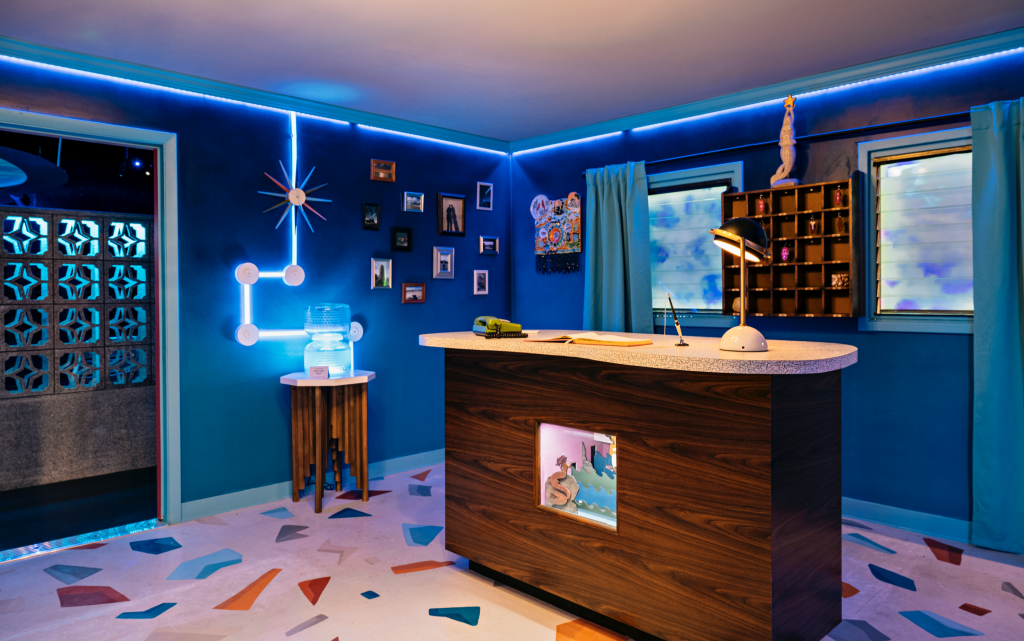
I was quick to become a Fairgrounds St. Pete Immersive member in 2021 and was among the first groups of guests to visit, and have been back since. The adventure begins in a throwback Florida motel lobby with no clear roadmap on where to head next (intentionally!). I took the route of focusing on the artistic aspects, wandering through each room, appreciating the aesthetics of it all and dissecting concepts behind the artwork. I’ve never been much of a gamer, but I watched those around me enthusiastically search for clues and discover hidden codes to trigger actions, such as an epic Everglades thunderstorm on the 50-foot projection screen (collaboration with Olivia Sebeskey). Fairgrounds St. Pete’s creative approach to gamifying the space is likely a strong entry point for many, though, for me, I was happy to explore it more like an art gallery.
A few installations, in particular, stand out to me: First, Mike Hicks’ A Mysterious Portal to the Bay. I almost walked past the small, dark niche toward the back of the building, but when I noticed it and walked up, I couldn’t pull myself away. It’s a quiet and unassuming installation depicting a bridge underpass that appears to extend miles into the distance over a body of water toward a city skyline. The gently ebbing water glints with blue light and creates a soft splashing sound over muffled cars passing above. It transports you, and that makes for a great piece of art.
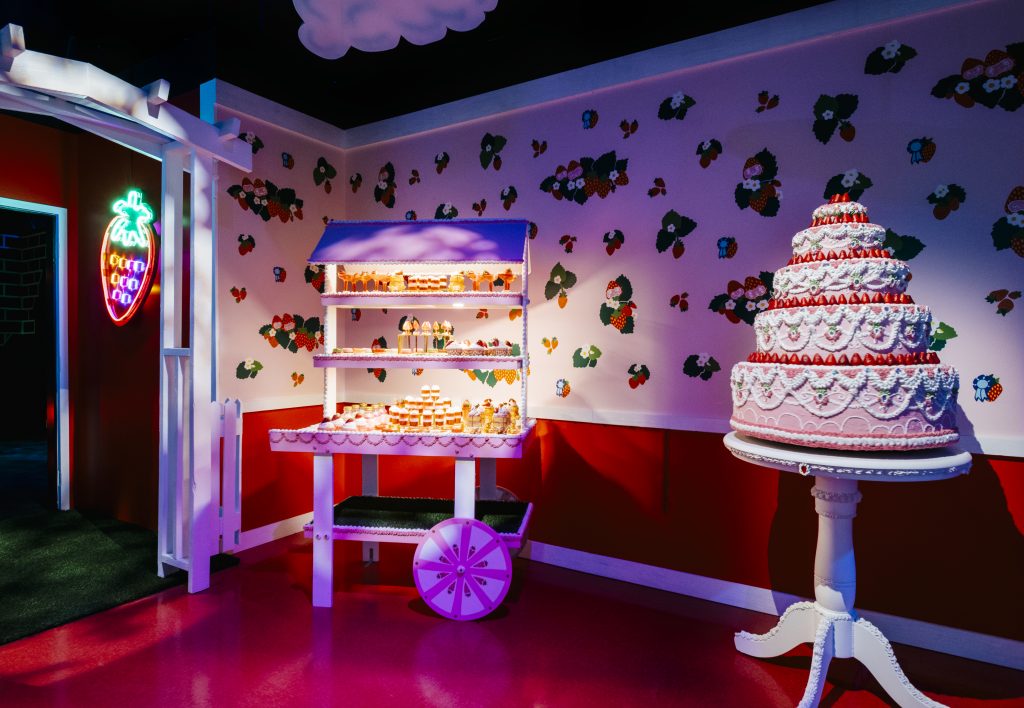
I also love the Strawberry Room by Macy Eats Paint and Emiliano Settecasi, for very different reasons. It’s sweet and delightful and hits a “critical mass” (as we say in the art world) of charming strawberry cuteness. It’s adorable, but also seductive and a bit hedonistic. It’s that little bit of edge that pushes it to another level, enticing you to plunder a decadent strawberry cupcake off the neat little dessert cart and scarf it down in three indulgent bites. (But don’t, it’s sculpture.)
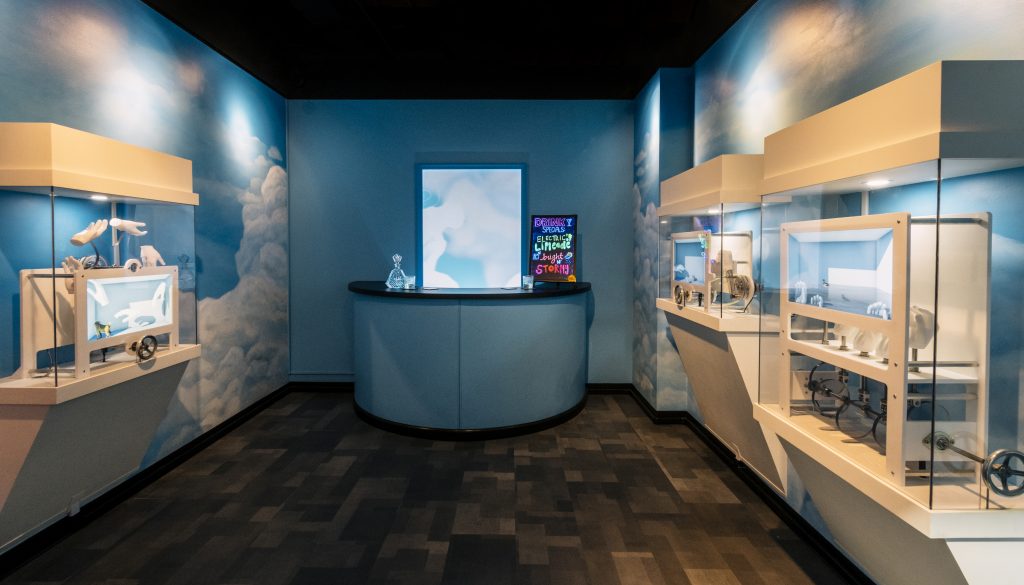
Electric Sky Lounge, which opened in March 2022 and features work by Neil Mendoza, is another stand-out for me. Hand-turned cranks control 3D-printed hands that exist seamlessly both as physical objects and digital images on the screens in front of them. You have full control over the hands’ simple movements, which impact cute and irreverently funny animations of animals: You can pet a shedding dog, smash a chicken, or upend a floating duck. Mendoza’s work awakened the gamer in me.
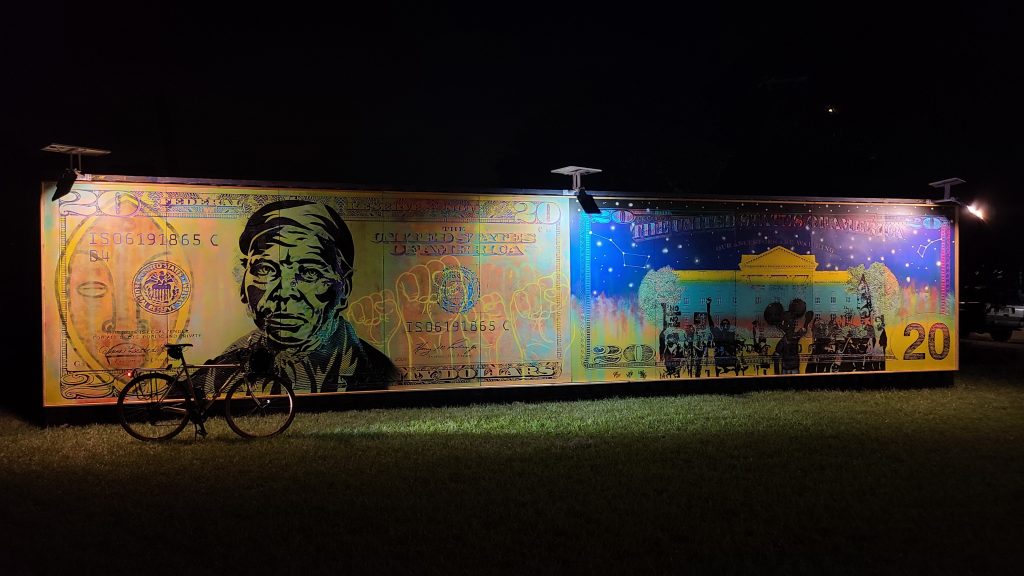
Tampa Bay’s next permanent immersive art attraction will be Crab Devil’s The Peninsularium, expected to open in 2022 in the Ybor Heights neighborhood of Tampa.* The Peninsularium starts in a reimagined Florida Bait Shop and continues on to a maze of 25+ shipping containers, each holding an artist-made, Florida-inspired installation; a subtle but discoverable overarching narrative lies below the surface. Crab Devil CEO Devon Brady writes:
“We want our viewers to be surprised by what they see, but we want the mechanisms by which that sense of surprise is achieved to be discoverable to the engaged viewer, and for that knowledge to give them a greater insight and appreciation for the real-world magic that surrounds us all the time. We like to bring the viewer in on the secret—to show them what we like to call “the artifacts of artifice.” We want our experiences to have depth—for them to reveal their secrets on both micro and macro levels.”20
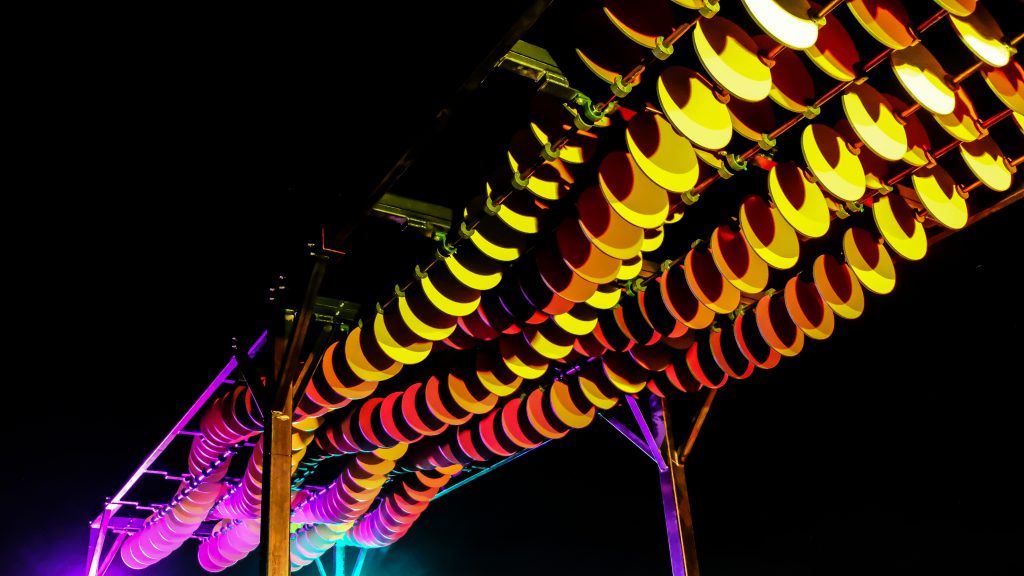
This intention is evident in the “preview” installations that Crab Devil has presented at Tampa events in the past couple years—Munchausen Waves at the 2021 Gasparilla Music Festival and The Bait Ball at Gasparilla Festival of the Arts earlier this year, both created by Devon Brady. Munchausen Waves is a kinetic sculpture and overhead shade structure inspired by a “Renaissance-era theatrical illusion developed by Italian stage illusionist Nicola Sabbatini.” It uses basic mechanics and mathematical synchronization to produce an optical illusion of an undulating wave-like surface.23 On one side, the discs are painted shades of red, orange, and yellow, evoking fire or the sun. On the other side, the discs are shades of blue and green, referencing water or the sky. The billowing colors are both calming and menacing, but you can also focus your eye—the way you would on a single blade of a fan—to see the simple composition behind the magical visual effect.
The Bait Ball is housed in a 40-foot shipping container, like many of the installations at The Peninsularium will be. Guests enter to find themselves inside a cage-like steel structure lined with illuminated kelp. On one end, a tiny peephole invites a look inside a miniature diorama depicting an underwater scene (by artist Phil Roach). On the other end, a round steel ball holding a grid of white fish begins to spin. The fish start to blur just as a strobe light turns on, transforming their blurred movement into a 3D zoetrope—out of nowhere, the fish appear to be swimming in a continuous circulating motion. Before you can pull your jaw off the floor, the strobe light turns off and the mechanics of the illusion are again revealed.24 As with Munchausen Waves, the curtain is pulled back, and what you see there only makes the work that much more compelling. Crab Devil approaches immersive art with tactile materials and analog technologies blended with media arts and modern technologies. I look forward to experiencing the completed attraction.
Recreating Historical Art as Immersive
I’ve encountered a range of skepticism on the subject of immersive art, but one common enemy seems to emerge: Immersive Van Gogh, and its contemporaries (immersive Monet, Kahlo, Klimt, etc.). Their primary offenses include: 1. The artist whose work is featured did not intend it to be presented that way (i.e. they’re all dead), 2. The physical medium in which the artist originally created their work is central to its significance (i.e. the fact that it’s a painting is fundamental), and 3. They are geared toward consumptive entertainment rather than thoughtful contemplation or meaningful experience. But, they are also a part of the region’s immersive art experience “scene” and demand inclusion.
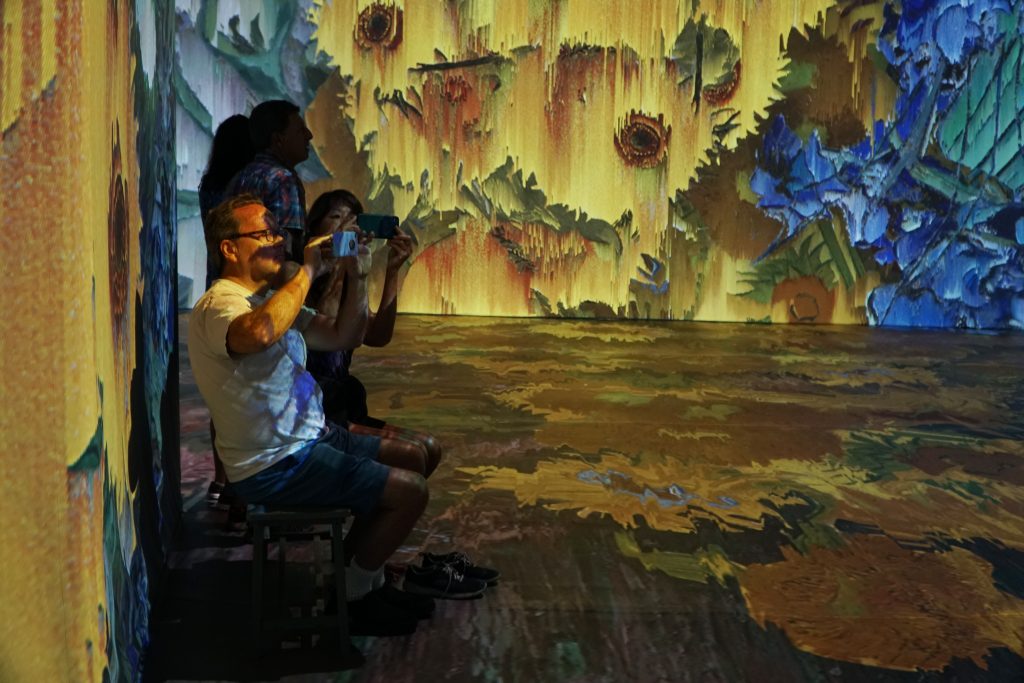
The art world’s palpable disdain for these kinds of attractions meant only one thing: I had to go and see for myself. So, I mustered all of my judgment-withholding strength and set off to see Beyond Van Gogh Sarasota and Michelangelo’s Sistine Chapel: The Exhibition. At a ticket price of $55.99, Beyond Van Gogh Sarasota (produced by Paquin Entertainment Group and Normal Studio), is located in a massive white tent in an empty field adjacent to the University Town Center Mall parking lot. Inside, the self-guided tour begins with an illuminated biographical timeline and information about Van Gogh’s work. A small room of colorful lights is the precursor to the main event: A 30,000-square-foot room with a 35-minute loop of wall and floor projections of Van Gogh’s work, sprinkled with historical quotes and photographs set to instrumental music and the occasional voiceover. Visitors seemed conscientious in reading about Van Gogh’s life and work, and gazed attentively—necks craned—at the kinetic animations of his famous paintings.
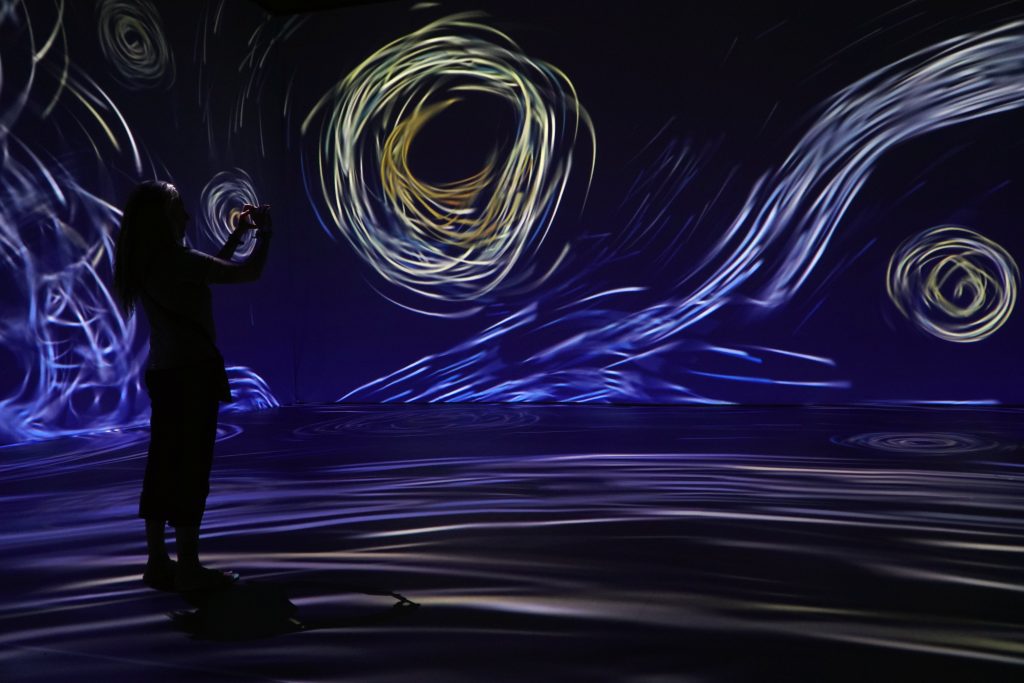
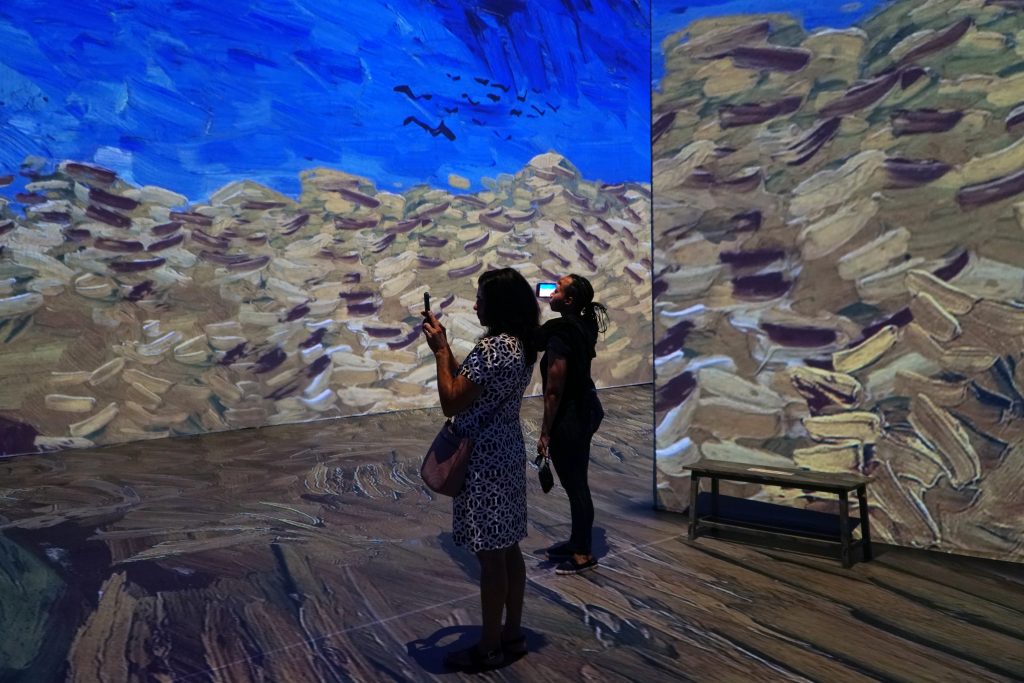

It was pretty, I’ll give them that—a fantastic choice for a Tinder profile picture background. But the wobbling projections and bold aesthetic choices on behalf of the creators were distracting for me. The animators made the sky swirl—an obvious choice—but also cut-and-pasted flowers from one painting over another, created an odd patchwork-quilt grid of Van Gogh’s signature, flew birds across skies, walked figures across city blocks, and superimposed slowly disintegrating paintings on top of each other as a transition effect. As Noelle Mason pointed out in our conversation back in April, the whole point of Van Gogh’s paintings is that they were paintings—his brushstrokes defied their static permanence and came to life on their own, without the assistance of an app.6 Beyond Van Gogh didn’t foster a deeper understanding or appreciation for me. In fact, it was a bit sad, having seen his work in person. Sorry, Van Gogh, capitalism did you dirty on this one.
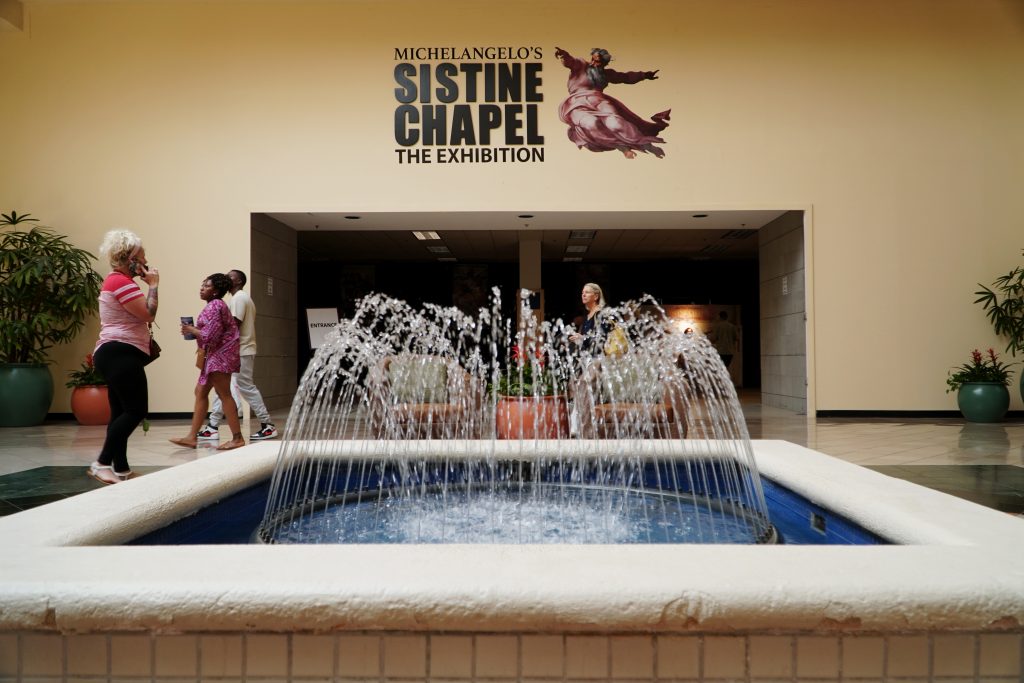
At Westshore Mall in Tampa, Michelangelo’s Sistine Chapel: The Exhibition (produced by SEE Global Entertainment and Bridgeman Images) is a few storefronts down from Selfie Wrld Tampa (perhaps the perfect Influencer one-stop-shop?). The familiar scent of Auntie Annie’s pretzels wafts through the air as you enter the gutted Sears department store. It’s a vibe. Inside, for a $22.60 ticket, you find larger-than-life prints of Michelangelo’s famed frescoes accompanied by informational text and a self-directed audio guide. Where Beyond Van Gogh focuses on an aesthetic experience, Michelangelo’s Sistine Chapel seems more focused on education. (To be fair, it isn’t advertised as “immersive,” but the terms “360-degree” and “experience” are used in their advertising.) The prints were a bit pixelated and the stained mall carpeting a bit depressing, but the text and audio information were thorough. The attraction was quite well-attended for noon on a weekday, mostly older folks but some young people, too. It was better than I anticipated, but in a different way.
Perhaps the question here is not, “What is the quality of the experience?” but, “What would the visitors be doing if they weren’t here?” Getting thousands of people to spend an hour or so learning about Art History before heading off to the food court is a major feat, one that museums struggle to accomplish. The popular, commercial aspect of these attractions provides access. As a reviewer of Michelangelo’s Sistine Chapel says, “We may never make it to Rome so this was a good substitute for us.” Or for others, it can be an inspiration—one Facebook user writes, “The bucket list now contains the yearning to see the real thing.”
Another gem Noelle Mason shared with me was that the (actual) Sistine Chapel is an immersive space and it was built so that everything around you inspires awe.6 This is absolutely true, and cathedrals, mosques, and other religious spaces may very well be the “OG” permanent immersive art spaces. The Sistine Chapel undoubtedly holds the potential to be an awe-inspiring space. But it’s worth noting that I went to the Sistine Chapel in my early 20s: My neck bent up toward the ceiling, shoulder-to-shoulder in a crowd of sweaty tourists while guards screamed, “Foto NO,” every three seconds when someone snapped an unauthorized picture—I don’t think this was Michelangelo’s vision either.
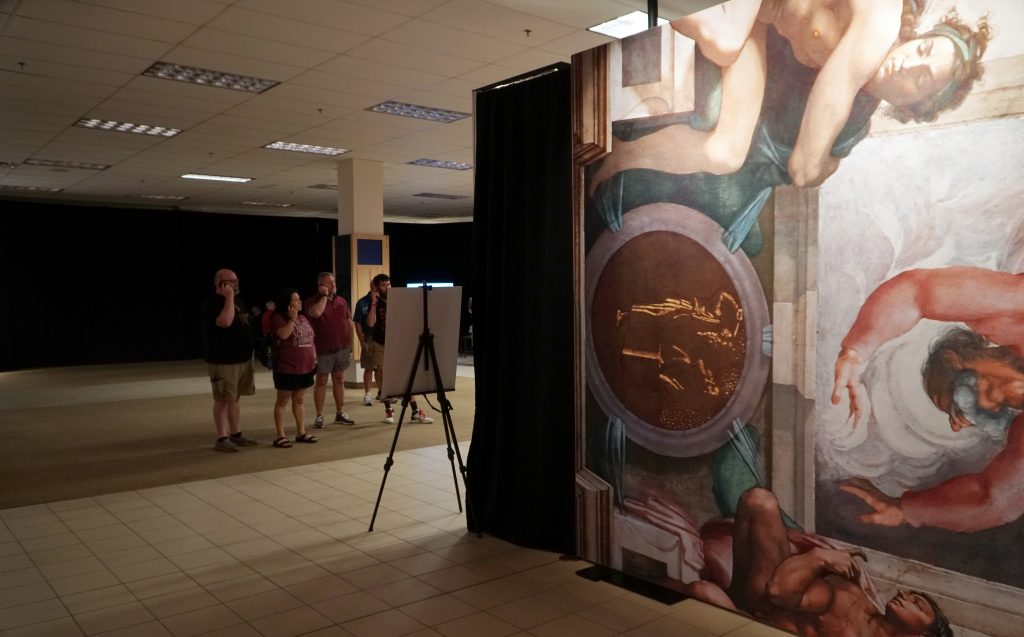
The lesson here, and perhaps the lesson for all contemporary immersive art spaces, is that you can’t force an “experience” on anyone. You can facilitate it, but experiences have to happen to you. A few weeks after that visit to the Sistine Chapel, I remember wandering into a little-known, mostly empty cathedral in Spain on an arbitrary Thursday evening. The golden-hour sun set the stained-glass windows ablaze and the gilded alter aglow, and the rehearsing choir echoed in the nave. Out of nowhere, I had an immersive arts experience, one I can remember far more vividly than many of the famous landmarks I visited. Perhaps one of the people I walked past in Westshore Mall, with its chipped tile and faint mildew scent, plastic audio guide pressed to their ear, staring on at Adam’s pixelated finger, had an experience. Who am I to judge?
Evaluating Immersive Art
Perhaps due to our global histories of these kinds of experiences, a major strength of immersive art is its accessibility. For many, an art museum is simply not welcoming: A chilly white room with signs reading “Do Not Touch,” a uniformed guard shushing, plaques with big words and old dates, accessed through an epic stone façade. It screams, “Not for everyone.” Immersive art asks you to touch, encourages photos, induces laughter, and speaks through entertainment instead of academics. It is familiar and democratized, providing more inclusive access to the arts, at least on a psychological level. (Ticket prices are sometimes quite high and can become a barrier to access.)
Larger audiences bring more money—and we all know funding to be the Achilles heel of the art world. What’s not to like about that? It’s worth noting here that immersive art experiences seem to be most popular in the heavily commercialized parts of the world: the U.S., Western Europe, and Japan. They can be money-makers, and that brings with it a focus on marketing, social media, and entertainment. The work may become too palatable, shifting the role of the artist from culture-maker to content creator.
I have yet to find an article written about immersive art that does not include the mention of Instagram or selfies. Is this a symptom of the immersive art-beast, or simply a sign of the times? We’ve all seen the Darwin Awards-esque news stories about people being gored by wild animals or plummeting from cliffs while trying to snap envy-inducing photos; we’ve read about natural wonders destroyed by hordes of selfie-takers. Perhaps in the 2020s any awe-inspiring visual scene will be reduced to influencer content to some degree.
Should immersive art welcome the free publicity? On the positive side, it increases revenue to the often-underfunded creative sector, and it bolsters access to art for those who feel excluded by high-brow galleries and museums. Or, should we admonish the dumbing down and corporatization of one of humanity’s greatest intellectual and cultural pursuits? Rather than conclude in strict “yes” or “no” answers, these questions can instead prompt thoughtful exploration into the intentions and outcomes of immersive art projects.
“True immersive art experiences ask us to use something called narrative transport. This is the idea of losing yourself in a story or getting caught up in one. When narrative transport is used properly, one of the values of the immersive experience is that it imparts a more profound meaning to the participant through use of kinetic sympathy, or accessing emotions by interacting with something. When narrative transport is used for something else—like advertising—it cheapens the whole label of immersive.”1
When it comes to art in any form, I’m a believer that all of it is valuable in its own way. Whether it’s a paint-by-numbers kit or an elaborate full-length opera, it’s all good for something. However, I also believe in applying a critical eye to the arts for the sake of education and advancement. As we develop the canon of 21st-century immersive art, we must also develop a rubric and language for evaluating it. What makes a high-quality immersive art experience? How does it move beyond superficial awe and photo backdrops to become transformative, profound, and intellectually challenging?
“We cannot resurrect the old system of art. Nor can we simply wish away the break that split apart the old system of art, arrogating intellect, imagination, and grace to fine art and disparaging craft and popular culture as the realm of mere technique, utility, entertainment, and profit. Like other dualisms that have plagued our culture, the divisions of the fine art system can only be transcended through a continuing struggle.”25
Just as in other art disciplines, evaluation investigates form and function: High-quality craftsmanship and technique, appealing aesthetics achieved through principles of design, compelling storylines, and a cohesive concept that is legible to the viewer are fundamental components of a successful work of art. Work should build upon historical references in innovative ways while contributing to contemporary conversations. Great artwork suspends time, stirs emotion, makes you view the world differently, and stays with you for years to come. Evaluating art of any kind is, of course, highly subjective, but the exercise is nonetheless important.
Conclusion
As much as immersive art experiences are enjoying a rise in popularity, they are also subject to a great deal of skepticism—from the general public due to their unconventionality, and from the art world due to their popular appeal. As Sarah Howard pointed out to me, this is not unlike any other medium of art experiencing a new rise in popularity: It took photographers decades to be considered artists; digital art wasn’t taken seriously until the 2010s; and today, we raise an eyebrow at NFTs. The immersive art field has a long road ahead to prove its chops and lower eyebrows, but I believe Tampa Bay has the talent and grit to take it on.
Thank you to the arts and culture leaders in the Tampa Bay community who took the time to speak with me on this topic: Janine Awai, Crab Reckoner at Crab Devil; Devon Brady, CEO of Crab Devil; the team at Fairgrounds St. Pete; Sarah Howard, Curator of Public Art and Social Practice for the Institute for Research in Art at the University of South Florida (USF); Noelle Mason, artist and professor at USF; and Tracy Midulla, Director of Tempus Projects. Learn more about Fairgrounds St. Pete at https://fairgrounds.art and Crab Devil at https://crabdevil.com.
*Note from the author: In full disclosure, I have been a part-time staff member of Crab Devil since January 2022. This article was written from my personal perspective—sparked by the cropping up of immersive experiences in the Tampa Bay region—and does not represent the viewpoints of any of my employers, past or present.
Jessica Todd is a writer, curator, artist, and arts administrator based in Tampa, FL. She is the Development Coordinator for Tempus Projects and the Administrative Coordinator for Crab Devil. Jess is passionate about building the creative infrastructures that support artists and arts organizations, as well as studying and addressing issues of equity, access, and inclusion in the arts. Prior to moving to Tampa in 2020, she was the Residency Manager at the Rauschenberg Residency in Captiva, FL for six years. She holds a BA in Metal Art & Technology from Penn State University and an MFA in Jewelry/Metals from Kent State University.
Endnotes
- Corinne Anderson, “How and Why Immersive Experiences Are Taking Over the Denver Art Scene,” 303 Magazine, January 8, 2020, https://303magazine.com/2020/01/immersive-art-denver-colorado/.
- Jacqueline Chanda. “A Theoretical Basis for Non-Western Art History Instruction.” Journal of Aesthetic Education 27, no. 3 (1993): 73–84, https://doi.org/10.2307/3333249.
- “Silver Clouds – Season of Warhol,” Memorial Art Gallery, University of Rochester, accessed July 8, 2022, https://mag.rochester.edu/exhibitions/silver-clouds/.
- Jonah Westerman, “Bodyspacemotionthings, Tate Modern 2009,” Tate, accessed July 8, 2022, https://Www.Tate.Org.Uk/Research/Publications/Performance-At-Tate/Perspectives/Robert-Morris.
- “About,” Rothko Chapel, accessed July 8, 2022, http://rothkochapel.org/learn/about/.
- Noelle Mason, interview by author, virtual, April 13, 2022.
- James Borchuck, Maggie Duffy, and Tailyr Irvine, Tampa Bay Times, September 26, 2018, https://www.tampabay.com/photos/2018/09/26/yayoi-kusama-love-is-calling-exhibit-at-tampa-museum-of-art-wvideo/.
- David Pendered, “Yayoi Kusama barred in 1966 from performing with ‘Narcissus Garden,’ now at Atlanta Botanical Garden,” Saporta Report, January 24, 2019, https://saportareport.com/yayoi-kusama-barred-in-1966-from-performing-with-narcissus-garden-now-at-atlanta-botanical-garden/sections/reports/david/.
- “James Turrell,” Guggenheim, accessed July 8, 2022, https://www.guggenheim.org/artwork/artist/james-turrell.
- “Ai Weiwei: Sunflower Seeds, 2010,” Tate, https://www.tate.org.uk/art/artworks/ai-sunflower-seeds-t13408.
- Grace Ebert, “A 79-Foot Labyrinth Crocheted by Ernesto Neto Hangs from the Ceiling of a Houston Museum,” Colossal, June 15, 2021, https://www.thisiscolossal.com/2021/06/ernesto-neto-sun-force-ocean-life/.
- Dylan Owens, “Meow Wolf: The Insane Art Collective Taking Over the World,” Rolling Stone, January 16, 2019, https://www.rollingstone.com/culture/culture-features/meow-wolf-expansion-psych-art-728202/.
- Meow Wolf, “Beyond, Beyond, and Beyond: Meow Wolf is Expanding into Texas,” Meow Wolf, May 11, 2022, https://meowwolf.com/articles/meow-wolf-new-texas-locations.
- Sarah Cascone, “‘The Whole Thing Is an Art Project’: Meow Wolf Cofounders Explain the Grand Plan Behind Their Wildly Popular Immersive Art Universe,” ArtNet News, October 20, 2021, https://news.artnet.com/art-world/meow-wolf-interview-2011837.
- Bea Mitchell, “The World’s Top 12 Immersive Art Experiences,” Blooloop, June 1, 2022, https://blooloop.com/technology/in-depth/immersive-art-experiences/.
- “Release – The Vinik Family Foundation presents The Beach Tampa by Snarkitecture,” Amelie Arena, July 18, 2016, https://www.amaliearena.com/news/detail/release-the-vinik-family-foundation-presents-the-beach-tampa-by-snarkitecture.
- Chloe Greenberg, “UK artist Lucy Sparrow’s ‘Tampa Fresh Foods’ felt grocery store is now open in Water Street,” Creative Loafing Tampa Bay, January 21, 2022, https://www.cltampa.com/arts/uk-artist-lucy-sparrows-tampa-fresh-foods-felt-grocery-store-is-now-open-in-water-street-12740616.
- “The Music Box: Tampa Bay,” USFCAM, August 9, 2016, https://usfcam.wordpress.com/2016/08/09/the-music-box-tampa-bay/.
- Sarah Howard, interview by author, Tampa, April 13, 2022.
- Devon Brady, email message, April 11, 2022.
- Tracy Midulla, interview by author, Tampa, April 5, 2022.
- Fairgrounds St. Pete Marketing team, email message, April 16, 2022.
- “Crab Devil Offers Exclusive Teaser of Immersive Art Installation to 2021 Gasparilla Music Festival Attendees,” Crab Devil, September 16, 2021, https://www.crabdevil.com/2021/09/16/crab-devil-offers-exclusive-teaser-of-immersive-art-installation-to-2021-gasparilla-music-festival-attendees/.
- “Crab Devil Celebrates Florida’s Exquisite Aquatic Ecosystem with Newest Installation at Gasparilla Festival of the Arts,” Crab Devil, March 3, 2022, https://www.crabdevil.com/2022/03/03/crab-devil-celebrates-floridas-exquisite-aquatic-ecosystem-with-newest-installation-at-gasparilla-festival-of-the-arts/.
- David Clowney, “A Third System of the Arts? An Exploration of Some Ideas from Larry Shiner’s The Invention of Art: A Cultural History,” Contemporary Aesthetics, vol. 6 (2008), http://hdl.handle.net/2027/spo.7523862.0006.004.

